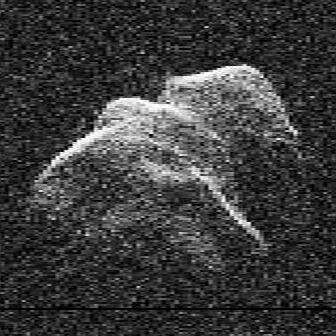A radar image of the Near Earth Object Toutatis. Astronomers studying the sizes of NEOs have concluded that an apparent unexpected excess of optically high albedo (bright) NEOs could be real, or could be the result of incompletely correcting for their rotational lightcurves. Credit: NASA and Steve Ostro, JPL
Near-Earth objects (NEOs) are small solar system bodies whose orbits sometimes bring them close to the Earth. NEOs are consequently potential collision threats, but scientists are also interested in them because they offer keys to the composition, dynamics and environmental conditions of solar system and its evolution. Most meteorites for example, one of the key sources of knowledge about the early solar system, come from NEOs. The large majority NEOs were discovered in optical searches, and today the total number of known NEOs exceeds 20,000. The crucial NEO parameter of interest for most problems, including the possible dangers from an impact, is the size, but unfortunately optical detections usually cannot determine size. This is because an NEO's optical light is reflected sunlight, and the object could be bright either because it is large or because it has a high reflectivity (albedo).
CfA astronomers Joe Hora, Howard Smith, and Giovanni Fazio helped lead the team that was the first to undertake the systematic measurement of NEO sizes using their infrared brightnesses. An NEO's infrared signal is the result of its thermal emission, and that provides an independent measure of its size. The team used Spitzer IRAC infrared observations of NEOs together with optical data and their sophisticated thermal model to break the size/albedo degeneracy and determine the sizes of NEOs. (The NASA WISE mission and its NEOWISE team subsequently also undertook infrared size determinations.) So far, infrared measurements have been made on over 3000 NEOs, the vast majority of them using IRAC. The smallest NEO characterized this way, so far, is only about twelve meters in diameter (with about a 20 percent uncertainty). But strangely, the results also suggest an abundance of high-albedo objects, nearly eight times more than had been expected based on the current thinking about the population distribution.
The scientists had previously analyzed and published the variations of NEO brightness that resulted as their non-spherical bodies rotated in space (their light-curves). They wondered whether the large apparent excess of high-albedo objects was the result of an inadequate correction for light-curve variations. They performed a statistical analysis using Monte-Carlo simulations to estimate what might be expected of a population of rotating, non-spherical NEOs. They conclude that while light-curve variations could indeed be the cause of the large high-albedo excess, the excess is also consistent with a real—and still unexplained—overabundance of shiny objects. They also concluded that whatever the explanation, it is unlikely that NEOs have albedos exceeding 50 percent. Additional observations of full NEO light-curves are need to resolve the uncertainties.
More information: Annika Gustafsson, et al. Spitzer Albedos of Near-Earth Objects. arXiv:1906.07284v1 [astro-ph.EP]: arxiv.org/abs/1906.07284
Provided by Harvard-Smithsonian Center for Astrophysics
























